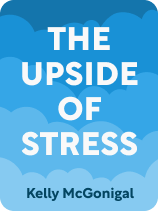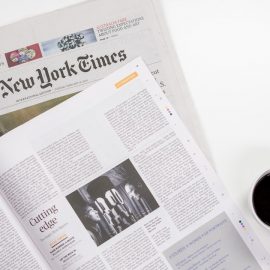

This article is an excerpt from the Shortform book guide to "The Upside of Stress" by Kelly McGonigal. Shortform has the world's best summaries and analyses of books you should be reading.
Like this article? Sign up for a free trial here.
What is positive stress? In what ways can stress be good for you?
Stress isn’t necessarily bad for you. Stress can actually be a good thing if it kicks in when you feel determined to achieve something or feel called upon to perform, but you don’t perceive your life to be at risk. Psychologist Kelly McGonigal refers to it as a “challenge stress response.”
Keep reading to learn about the benefits of the challenge stress response, according to McGonigal.
Challenge Response
What is positive stress? According to McGonigal, positive stress is stress in response to a challenge but without perception of real threat or danger. A challenge response energizes you for action without harming your health. Like the fight-or-flight response, a challenge response ramps up your breathing and heart rate to help you perform. However, because you don’t perceive a threat, your body doesn’t brace for injury by increasing inflammation and constricting your blood vessels—and McGonigal claims that these symptoms cause the harmful health effects associated with chronic fight-or-flight mode. Instead, your blood vessels remain relaxed, inflammation throughout your body does not increase, and you actually gain more energy than you do in a fight-or-flight response because your muscles receive more energy from increased blood flow.
(Shortform note: McGonigal points out that a challenge response to stress removes the harmful physiological effects of stress while retaining and even enhancing certain benefits, like increased energy production. However, one expert notes that the positive effects of a challenge stress response may lead to harmful behaviors. For example, the dopamine produced during stress feels good and creates motivation, which can cause challenge stress to become addictive. Thus, addiction to challenge stress’s feel-good effects could lead to over-exercising or workaholism, which can interfere with your daily life and relationships.)
A challenge response also enables you to recover and learn from stress more effectively. This is because, during a challenge response, you produce a higher ratio of the hormones DHEA to cortisol in your blood. DHEA increases the brain’s capacity to learn from stressful experiences. It also enhances immune function and injury repair. Cortisol helps you create and use energy efficiently during stressful situations by turning sugar and fat into fuel and pulling energy away from processes like digestion and growth. A higher ratio of DHEA to cortisol aids your recovery from a stress response by improving your heart and brain health. When the opposite happens and cortisol levels rise (which is typical in a threat response), it can result in immune system dysfunction, depression, and anxiety.
(Shortform note: Because a high DHEA is known to benefit your body and mind, it’s important to maintain a healthy DHEA/cortisol ratio. Research suggests that your DHEA levels peak between ages 20 and 30, and then decline slowly with age. However, one study shows that you can naturally increase your DHEA level throughout your lifetime with regular exercise, especially resistance training.)
In a challenge response, your body releases other hormones like adrenaline and dopamine to increase energy, motivation, and focus. However, because you don’t perceive a threat, you feel confident rather than afraid. McGonigal claims that increased confidence, along with elevated energy, allows you to perform better during exams, competitions, and at work.
A challenge response even enables you to perform better than if you have no stress response. One study observed the difference between a challenge response and a threat response using the Trier Social Stress Test—a stress-inducing simulation that requires participants to give a spontaneous presentation and take a surprise math test in front of unsupportive judges. Participants with a challenge response had more confidence, performed better, and had a healthier post-test mental state than participants who exhibited threat responses or low-stress responses.
| McGonigal’s use of the term challenge response has been criticized for its unoriginality and inaccuracy. One critic notes that psychologists dating back to the 1950s have already established that different perceptions (or cognitive appraisals) of stress can cause different mental and physical reactions. The same critic also claims McGonigal’s categorization of the challenge response as a stress response is flawed, arguing that reframing stress as a challenge is simply a cognitive appraisal of stress, not a stress response itself. He argues this is because stress is fight-or-flight and consists of physical responses that are independent of your mental perception. Defenders of this book might say that although McGonigal doesn’t mention cognitive appraisal, she doesn’t claim to be the originator of this concept. However, she’s researched the potential benefits of this stress response and considered them to be worth sharing. Contrary to the critic’s claim, McGonigal’s research supporting the challenge response demonstrates that mindset (or appraisal) isn’t independent of stress physiology. For example, one study shows that a positive perception of stress improves confidence and enhances cardiovascular function. Regarding the validity of a challenge stress response, it seems to have originated as an aspect of the biopsychosocial stress model of challenge and threat, which theorizes that your stress response is determined by your perception of a situation’s demands and your ability to face them. If you perceive that the demands exceed your ability, you induce a threat response. In contrast, if you perceive that you possess the resources to handle the demands of a situation, you cause a challenge response. |
Focus On Your Resources
In order to prompt a challenge response when you’re facing a stressful situation, McGonigal suggests taking account of your resources.
Psychological research shows that the most important determinant of your response to stress is your mindset about your ability to handle a given situation. If you don’t feel like you have the resources necessary to handle a given situation, you’ll induce a threat response. On the other hand, if you feel like you’re capable of taking on a situation, you’ll be more likely to induce a challenge response. In order to trigger the latter response when you’re faced with a difficult situation, McGonigal says to keep the following resources in mind:
- Acknowledge strengths that can help you.
- Think of moments in your past when you’ve handled similar situations well.
- Think of loved ones or friends who can offer support.
- Pray or imagine other people praying for you.
- Think of your stress response itself as a resource.
| Although McGonigal presents the challenge and threat responses as distinct reactions, one analysis argues that these responses can actually coexist to varying degrees depending on the situation. This is possible because our brain can process both positive and negative information at once through distinct neural systems. For example, you might feel capable of getting the winning hit at your softball game, but at the same time feel worried that the hard-throwing, wild pitcher might bean you with the ball. So, your body responds in a way that helps you perform but also prepares you for injury. To build resources that give you confidence and prime you for a challenge response to stress, consider applying the broaden-and-build theory of positive psychology. This theory proposes that practicing healthy habits leads to positive emotions, which in turn causes you to broaden your perspective and build resources to cope with negative emotions. For instance, if you practice the habit of regularly complimenting people, perhaps you’ll feel happier and friendlier. These feelings will motivate you to engage more with other people and build supportive relationships. Thus, the broaden-and-build theory can help establish or enhance supportive relationships with loved ones as well as other beneficial resources that McGonigal highlights. For example, this theory also encourages engaging in a spiritual practice, which can develop your ability to pray. |

———End of Preview———
Like what you just read? Read the rest of the world's best book summary and analysis of Kelly McGonigal's "The Upside of Stress" at Shortform.
Here's what you'll find in our full The Upside of Stress summary:
- Why stress is an ally that should be embraced
- How stress can lead to enhanced health, greater success, and a more meaningful life
- How to change your mindset about stress to receive its benefits






